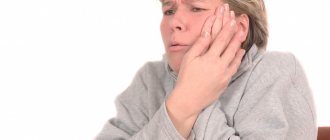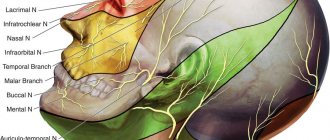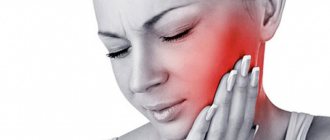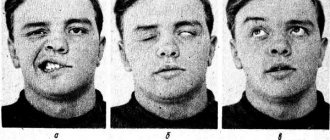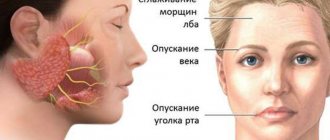Symptoms
The inflammatory process begins to develop gradually. At first there may be a feeling of pain behind the ear, but after a few days facial asymmetry occurs. The patient has a drooping corner of the mouth on one side, and the eye on the affected side squints poorly. When you try to close your lips into a “tube” on the affected side, your mouth becomes distorted. When you try to “blow out the candle,” the cheek on the affected side “sails.” There may be lacrimation from the eye on the affected side. With this pathology, a person loses the sense of taste on the front of the tongue. Hearing disturbance and increased salivation may occur. When closing an eye on the affected part of the face, the eye may not close completely. The patient's smile is asymmetrical. Symptoms develop over one or two days.
Exercise therapy for facial neuritis
There are many diseases in neurological practice that require increased participation in the treatment of the patient himself. The correct daily routine, general recommendations and physical therapy, even without drug intervention, sometimes allow one to achieve good results.
The situation with neuritis of the facial nerve is no exception. Exercises for this pathology are extremely important. They must be started from the first day of illness. Competent and regular exercise therapy in combination with proper medication and physiotherapeutic treatment, as well as taping therapy, leads to the best results. After all, regular exercise allows you to improve tissue microcirculation, help restore the conduction of nerve impulses along the nerve, and strengthen paretic muscles.
The set of exercises should be performed twice or thrice a day. It is advisable to perform all exercises in front of a mirror, monitoring, first of all, the technique and quality of execution, strictly observing the symmetry of the movements on the healthy and sore side. Most often, during the exercise, it is necessary to fix the healthy side of the face, not allowing it to work. Otherwise, increased work of the muscles on the healthy side will occur, while the muscles on the diseased side will only weaken and facial asymmetry will increase. The list of exercises is given below:
- Close your eyes, check if your eyelids twitch, then slowly close your eyes.
- Open your eyes, close them, fixing your gaze on the tip of your nose, and use your finger to help the eyelids on the painful side close.
- Frown with a little effort, help with your fingers on the painful side.
- Raise your eyelids and eyebrows upward.
- Try to inflate your nose.
- Place your fingers on the wings of your nose and press while inhaling, resisting the air flow.
- Gradually, using your hand, pull back the immobilized corner of your mouth, opening the side teeth.
- Gently close your lips, stretch them, while pronouncing the sound “I”.
- Suck your cheeks in as you inhale and, stretching your lips with a tube, exhale.
- Inhale and puff out your cheeks, trying to keep both sides of your face symmetrical.
- Inhale through your mouth, curling your tongue into a tube.
- While exhaling, snort 4-5 times
- Move your tongue between your cheek and teeth on both sides.
- While exhaling, whistle for 3-4 seconds.
- Make a surprised face, raising your eyebrows up, press the healthy side with your hand for less development of movements. Start with 5-6 repetitions, gradually increasing to 20 times.
- Make an angry face, also raising your eyebrows, otherwise the execution is the same as exercise number 15.
- Close your eyes at different paces against the background of the downward movement of the eyeballs. If the eye does not close completely, you can clench your teeth, help with your finger, releasing your finger, try to leave the eye closed. Start with 3-4 repetitions, gradually increasing to 10.
- Blink your eyes for 5-6 seconds.
- Wrinkle your forehead, resisting the healthy side. You should monitor the symmetry of movements.
- Puff out your cheeks and then pull them in.
- Blow soap bubbles by stretching your lips with a tube and making sure your face is symmetrical.
- Bare your teeth, keeping a healthy corner of your mouth and making sure your movements are symmetrical.
- Grab the lower lip with your upper teeth, and then the upper lip with your lower teeth.
It is advisable to do exercises after visible improvement, and even recovery. Also, exercises should also be performed for a long time in case of post-traumatic injuries, as well as in case of persistent residual effects. After all, exercise therapy allows you to reduce the frequency of long-term negative consequences of facial neuritis, such as, for example, synkinesis.
Tests and diagnostics
A neurologist makes a diagnosis based on the patient’s complaints and clinical picture. The neurologist may ask you to make movements with your facial muscles - close your eyes, bare your teeth, raise your eyebrows, puff out your cheeks or whistle, and wrinkle your nose. Such tests allow the doctor to determine the presence of neuritis. If the diagnosis is in doubt, the doctor may prescribe the following tests:
- CT, MRI;
- Electroneuromyography (ENMG);
Additionally, the neurologist may recommend consultation with a neurosurgeon and otolaryngologist.
Complications of neuritis
In the absence of appropriate treatment for inflammation, the health condition worsens and various complications develop. Neuritis is characterized by:
- motor disorders of muscle groups;
- loss of sensation;
- muscle atrophy.
Drooping of the eyelid, formation of contractures, deterioration of vision, limited movement of the eyeball, lack of movement of the facial muscles, speech impairment, shortness of breath, pain in the hypochondrium, radiating to the neck and shoulder, etc. may occur.
To stop the deterioration of the health condition, drug treatment of neuritis is extremely necessary; it is prescribed individually, taking into account which nerve is inflamed and how advanced the situation is.
Treatment of neuritis of the facial nerve
Treatment begins with drug therapy to relieve swelling and inflammation. Treatment may include the following groups of drugs:
- glucocorticosteroids;
- vasodilators;
- diuretics;
- B vitamins (in the absence of allergic reactions);
- non-narcotic analgesics;
- Moisturizing drops may be prescribed for the eyes to prevent dry mucous membranes.
With secondary neuritis, it is necessary to treat the disease that caused the neuritis.
Symptoms of neuritis
Regardless of which nerve is inflamed, the very first signs of the disease are numbness and the presence of pain of varying intensity. Without treatment, symptoms gradually increase, and the following appears:
- disturbance of sensitivity - a large area becomes numb, paresthesia appears, disappearance/decrease in sensitivity;
- activity disorder - a decrease in muscle strength, the occurrence of processes caused by insufficient tissue nutrition, impaired tendon reflexes;
- vegetative and trophic degradation changes - blueness and swelling in the affected area, sweating or dry skin, the occurrence of trophic ulcers, brittle hair and nails.
Inflammation of the facial nerve is accompanied by asymmetry of the face - one part is relaxed and does not move, does not droop, or, on the contrary, the eyelid does not rise, the muscles of the forehead do not tense, and pain occurs behind the ear. If the femur is affected, movement in the knee and hip joints worsens, the muscles weaken, and their dystrophy develops.
Consequences and complications
Treatment must be started as quickly as possible, because
a year after the onset of the disease, the muscles will completely atrophy and their functionality cannot be restored. Complications may occur if therapy is not started at the first signs of the disease. With a long course of the disease, contracture of the facial muscles may occur, which is very difficult to restore. Disturbances in the sense of taste, visual disturbances (blindness, corneal ulcer), spasm of the muscles of the face and eyelid may occur. Consequences after the disease in some cases can last a lifetime.
Sets of exercises for the basic period of treatment
The base period is the time of onset of the disease: from 1 to 10 days. At this time, the patient is put on a special corset for the face (position therapy) and begins therapeutic exercises. The exercises used during this period are preparatory and basic. Therefore, overload should not be allowed: training is carried out 2 times a day for 10 minutes each.
Note!
The main task of the base period is to strengthen the muscle tone of the healthy part of the face.
Before you start training, massage your face for 2-3 minutes, gently rubbing the skin:
- Using circular movements on the closed skin of the eyelids;
- Along the wings of the nose with stroking movements up and down;
- Along the line of the eyebrows from their middle to the temples.
Self-massage of the face is also carried out after the basic complex is completed.
Let us give examples of therapeutic exercises for neuritis of the facial nerve in the base period.
- Tighten and relax the muscle tissue of the healthy part of the face;
- Tighten the muscle tissue that is involved in the facial expressions of a certain group;
- Speak sounds that involve the lips (p, b, v, m, o, u, f).
Performing these exercises in class prepares the facial muscles for basic training.
Diagnosis of neuritis
When diagnosing inflammation, the doctor performs various functional tests. Their purpose is to determine motor function disorders. There are two forms of the disease - mono- and polyneuritis. If in the first case the inflammation is local in nature, one nerve is inflamed, then in the second - several.
For each type of neuritis, its own specific tests are carried out. Thus, with inflammation of the radial nerve, it is not possible to place the 3rd finger on top of the others; in a vertical position with arms down, the patient is unable to turn the hand palm up, has difficulty or is unable to move the thumb, etc.
When the ulnar nerve is damaged, the patient cannot clench a fist, it is very difficult to bend the 4th and 5th fingers, the terminal phalanx of the first does not bend - it is impossible to hold thin flat objects.
With inflammation of the median, it is impossible to oppose the thumb and little finger; due to poor flexion of the fingers, the hand cannot be clenched into a fist.
When the sciatic nerve is damaged, acute discomfort occurs in the lumbar spine, their intensity depends on the level of damage (tingling, numbness, increasing pain, convulsive muscle contraction are observed).
To prescribe treatment, it is necessary to determine the level of nerve damage. For this purpose, various electrophysiological methods are used. It is also impossible to treat without determining the cause of the disease. For this purpose, a general and biochemical blood test and MRI are performed.
Does it help with inflammation?
Massage is quite an effective remedy for this disease . However, it must be prescribed by a doctor.
The fact is that during the acute period (approximately the first week) massage is contraindicated. But after the acute manifestations are relieved, the use of certain techniques not only helps eliminate pain, but also speeds up the healing process.
With proper treatment - a combination of medications and professional massage - recovery and muscle restoration occurs much faster.
You can do it yourself or contact a specialist . However, when performing self-massage, it is necessary to consult with a specialist and study the technique in detail.
Learn about other treatments for Bell's palsy: exercise therapy and acupuncture.


